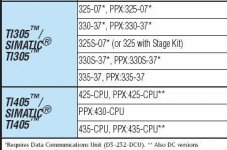Looking at the Siemens page, the first line in their page says...
SIMATIC 505 - It Doesn't Get Any Easier Than This!
Having used several other PLC wanna-be's that shall remain un-named (Oh, what the hell... AB, GE, Tele-Mechanique, Modicon, Mitsu, Omron, S7's and just enough of the S5's to make me shudder and run.), I totally agree with that statement.
BTW, I haven't used AD, but from Tom's descriptions and what I've read, it's a mathematical-modeling nightmare (primarily BCD-based???).
I don't believe I've seen Siemens shower so much, well-deserved, praise on any of their own so-called "Flagships".
It just kills me that they are treating THEEEE best PLC on the market as they do.
I could almost understand this if they were indeed trying to bring the TI-philosophy into their own PLC's. However, what I see happening is that the S7's are becoming more and more S5-ish... Yikes!
Wouldn't the rest of you TI-Huggin'-Guys just love to be able to throw-in and buy the TI-505 Line from Siemens? I sure would!
However, I'll bet there is no way in hell that Siemens would ever let it go.
Why? I believe that Siemens would rather keep the TI-505 Line and let it die because they know that competition from the TI-505 Line would crush them in the American Market.
Don't you know??? That is why they bought it in the first place! It's that age-old capitalist technique... buyout your most threatening competitor and then let it die... even if it is better, let it die! Loyal users go to hell! But wait... honestly, we have something better!
I ain't seen anything better from those ba$tards yet! It appears it's gonna get a lot worse before it gets better!
To those of you that are S7 and (yuk) S5 users that sing the praises of those lines, and have yet to use the TI-505 Line... those of you that haven't tried TI-505... well, you simply DO NOT KNOW!
I'm sooo pi$$ed at TI for doing this to us! (I wish they called me first... and I wish I could have dissuaded them from selling to Siemens! Damn... if I only had a few serious-bucks in my pocket! DOUBLE-DAMN!)
"Kenny-beer",
Aside from enhanced programming capabilities and/or improvements in communication or management, the usual enhancement associated with the step from -110(X) to -110(X+1) is memory size.
It does no good to call for a larger memory size when that memory size doesn't exist.
BTW, Kenny-beer, you have a $hit-load of memory available to use!
You should be able to add quite a bit more code before you significantly affect the detection of signal transitions.
I don't know the exact nature of your application but you have lots of room to install a mathematical model of your process so that the code can "KNOW" when something is going wrong before it goes too far wrong! That is, "KNOWING" what should be happening at any given time gives the program a chance to handle problem-issues as they are developing!
BTW-2, many programmers look at the RAMP-SOAK routine only as a means to control temperature (typical example in the manuals). It can also be used for many Motion Control issues. It is really, really flexible in terms of the controlled device. You can use it as a primary controller to control the Analog Output to some device.
SIMATIC 505 - It Doesn't Get Any Easier Than This!
DAMN! I LOVE THIS STUFF!
After about 150 edits, many of them MGD-induced... I'm done.
Flame-Shields down... burn on mates, burn on.







